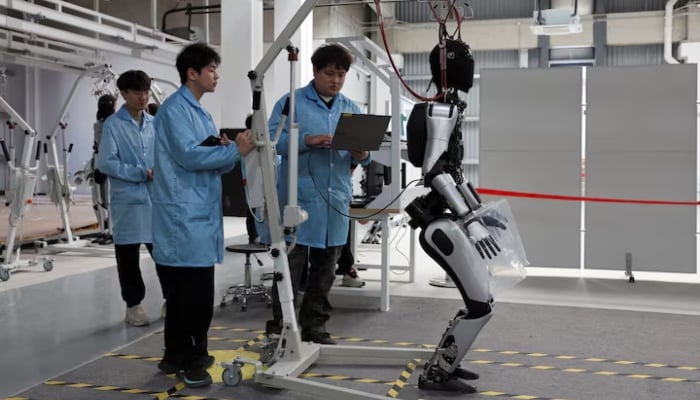China's AI-powered humanoid robots aim to transform manufacturing
Chinese humanoid startup AgiBot aims to generate reams of data and use it to train robots
May 13, 2025

In a sprawling warehouse in a Shanghai suburb, dozens of humanoid robots are manoeuvred by their operators to carry out tasks like folding a T-shirt, making a sandwich and opening doors, over and over again.
Operating 17 hours a day, the site's goal is to generate reams of data that its owner, Chinese humanoid startup AgiBot, uses to train robots it hopes will become ubiquitous and change how humans live, work and play.
"Just imagine that one day in our own robot factory, our robots are assembling themselves," said Yao Maoqing, a partner at AgiBot.
The importance of humanoid robots to Beijing, as it looks for solutions to pressing issues including trade frictions with the United States, population decline, and slowing growth, was underscored when Chinese President Xi Jinping inspected AgiBot's robots in Shanghai last month. Xi jokingly remarked during the visit that perhaps the machines could play in a football team.
Another domestic developer of humanoid robots, Unitree, was also present in a meeting Xi hosted for private firms earlier this year, where he urged them to help China's economy.
As the US negotiates with China over tariffs that President Donald Trump had imposed to help bring back US manufacturing jobs, Beijing is aiming for a new industrial revolution where many factory tasks would be performed by humanoid robots.
In recent years, Chinese humanoid robots have demonstrated increasing feats of agility, including performing somersaults, running a half-marathon, and even playing football, as Xi mused.
But Reuters is reporting for the first time details about how China's advances in artificial intelligence, partly driven by the success of homegrown firms like DeepSeek as well as abundant government support, are allowing humanoid developers to pair the robots' already impressive hardware with the software needed to make them economically valuable.
Reuters spoke to more than a dozen people, including Chinese humanoid manufacturers, investors, customers and analysts, who described how breakthroughs in developing robot "brains" will allow these metallic machines to go from mere spectacles to productive and autodidact workers that could revolutionise the world's pre-eminent manufacturing power.
China aims to build its edge by focusing on data training and the sophistication of its AI models, the people said, with some saying the prowess of DeepSeek was a big aid.
DeepSeek and the Chinese government didn't respond to requests for comment about their roles in the development of humanoid robots.
A successful and widespread deployment of these robots in factory floors would enable China to keep driving economic growth and maintain its manufacturing superiority, making the field an area of competition with the US.
Less clear is how Beijing would manage the spectre of layoffs of factory workers. State media has suggested that, as with previous industrial revolutions, long-term job creation would outweigh short-term pain.
Chinese authorities are handing out generous subsidies for humanoid firms. More than $20 billion has been allocated to the sector over the past year, and Beijing is establishing a one trillion yuan ($137 billion) fund to support startups in areas such as AI and robotics, official announcements show.









